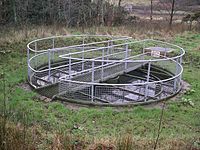
Photo from wikipedia
Abstract This work studied the effects of nutrients on metal tolerance, removal efficiency, and metal accumulation in tissues of T. domingensis. This macrophyte was exposed to solutions of Cr(III) + Ni + Zn at… Click to show full abstract
Abstract This work studied the effects of nutrients on metal tolerance, removal efficiency, and metal accumulation in tissues of T. domingensis. This macrophyte was exposed to solutions of Cr(III) + Ni + Zn at extremely high concentrations. Treatments were metal combinations of 200 or 600 mg L−1 of each metal with and without nutrients (N and P). Treatment 600 exhibited significantly lower final metal removals than those of 200. The highest removal from water in all treatments was registered for Cr. Final Cr removal did not show significant differences between the treatments with and without nutrient addition. Sediment showed higher concentrations than plant tissues. Roots exhibited the highest Cr concentrations in tissues. In comparison with roots, leaves did not show significant differences in Ni and Zn concentrations, except for 200 and 200 + nutrient. Treatments with nutrient addition reached a significantly higher relative growth rate (RGR) than that obtained in treatments without nutrient addition. Treatments 600 and 600 + nutrients showed a significantly lower RGR than that of treatments 200 and 200 + nutrients. In Treatment 600 the lowest chlorophyll concentration was observed. T. domingensis demonstrated its ability to survive a fortuitous industrial dump of high metal concentrations in a treatment wetland.
Journal Title: Ecological Engineering
Year Published: 2020
Link to full text (if available)
Share on Social Media: Sign Up to like & get
recommendations!